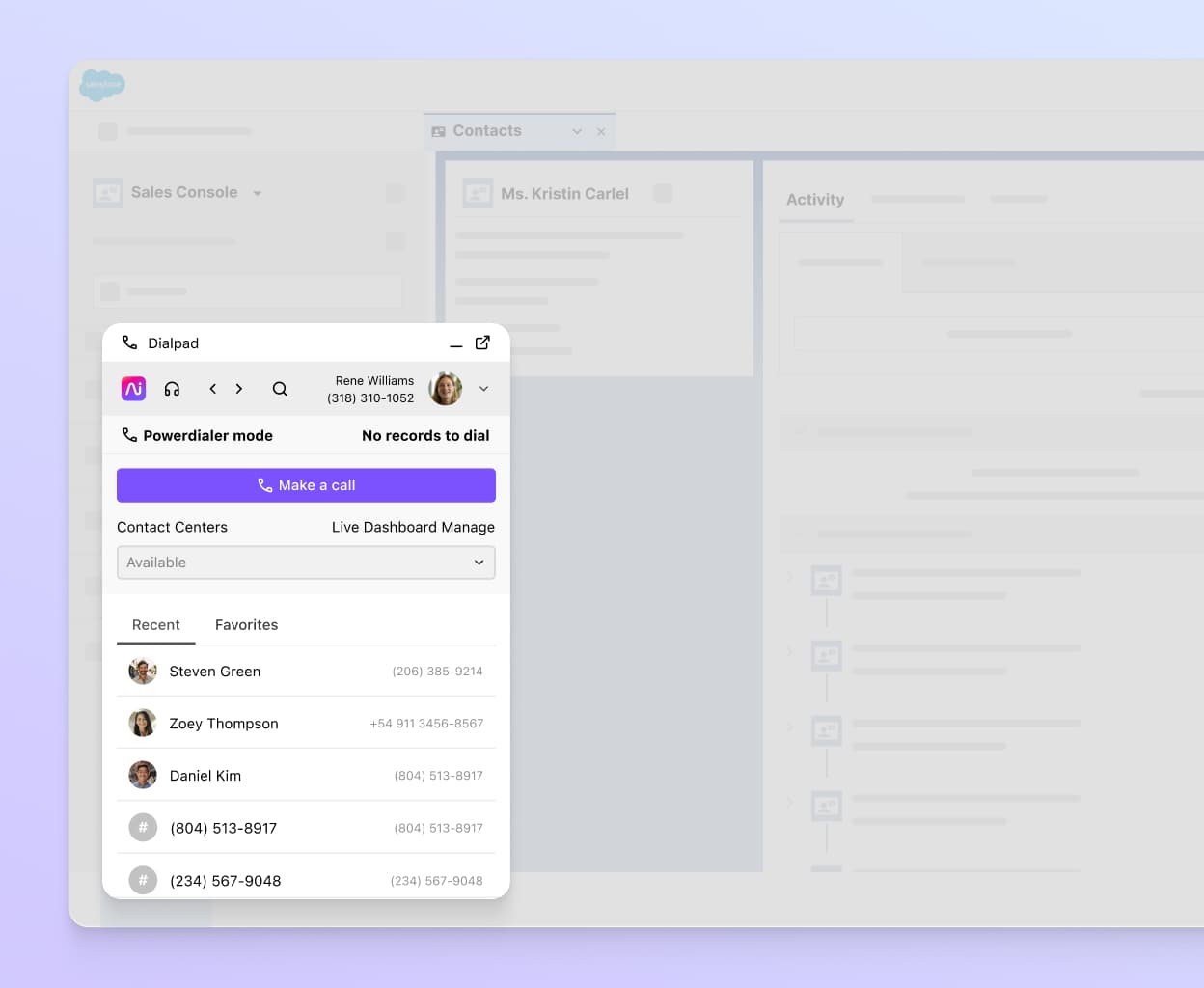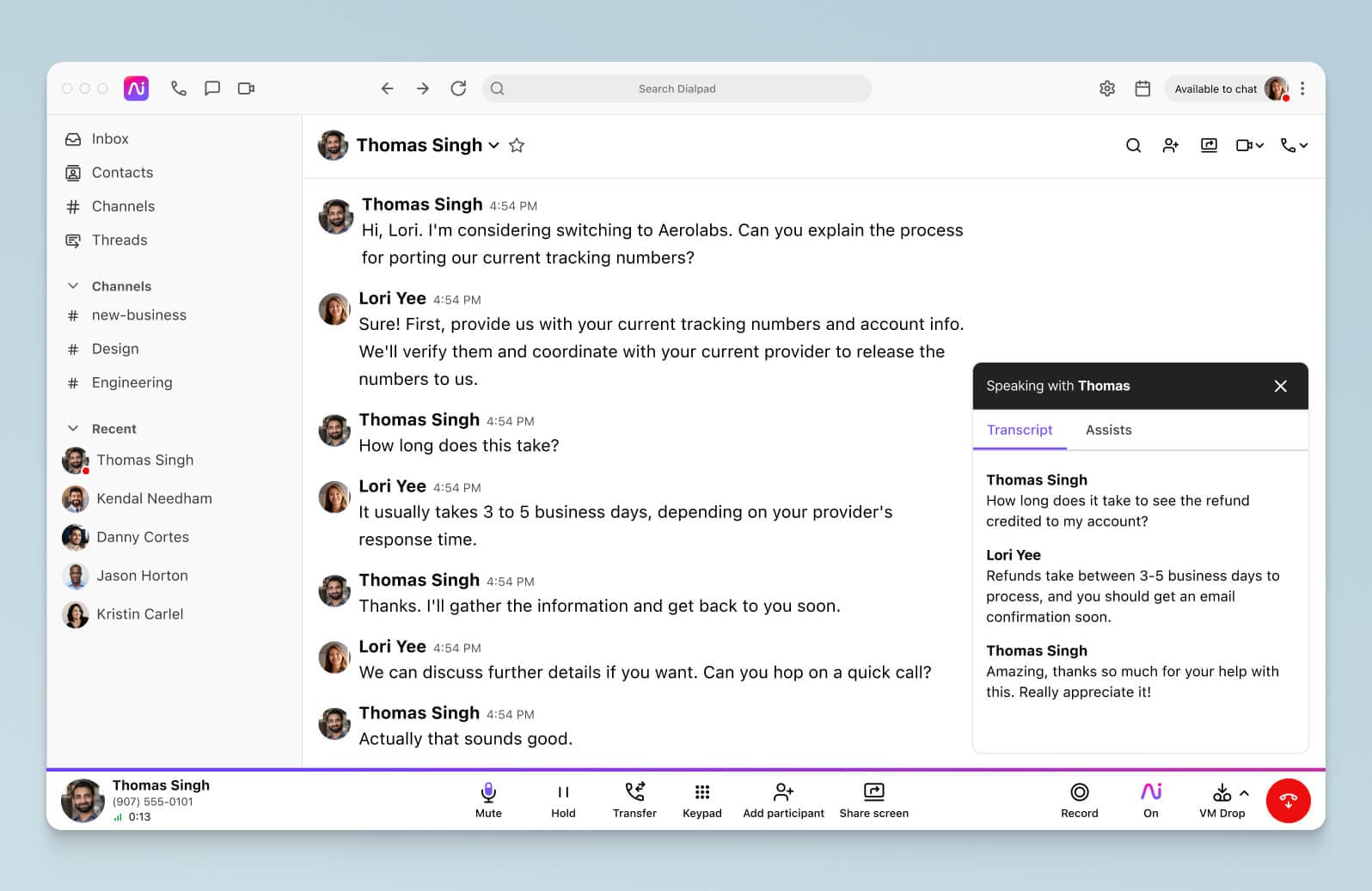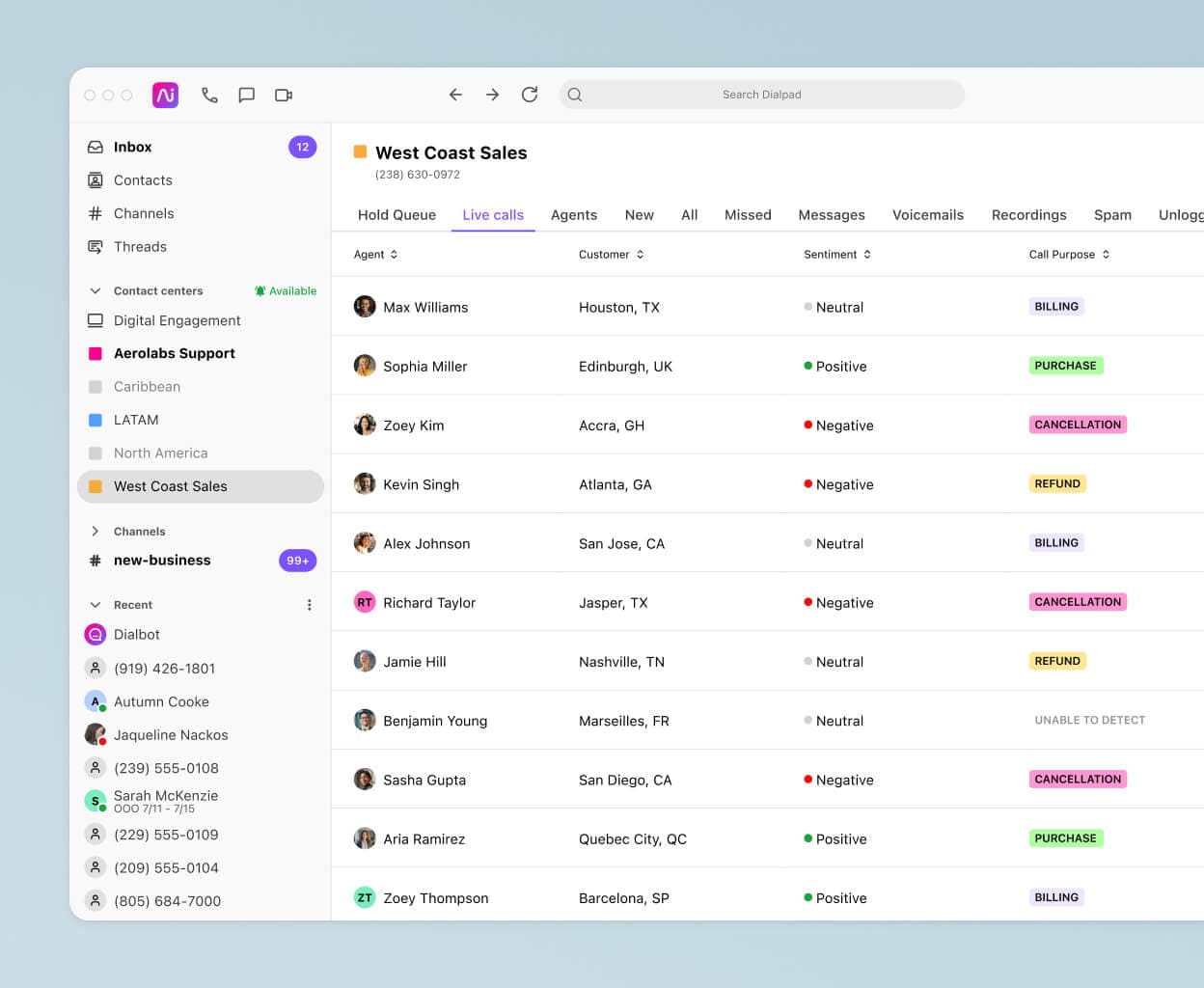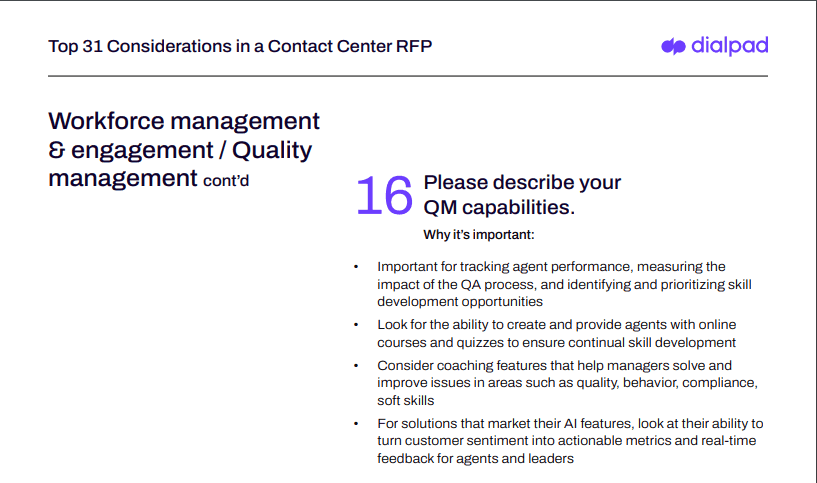
Tags
Share
If you’re running a contact centre or call centre, but don’t have the software to support you quite the way you like yet, then an RFP (request for proposal) might be something you’re considering as you’re shopping.
But what should you include in your contact centre RFP? It shouldn’t just be a checklist—yes, there are lots of contact centre RFP templates out there, but not all of them are necessarily tailored to your business, or even your industry.
Beyond just the basics (like IVR routing, or inbound and outbound functionality), what should your business be looking for in a contact centre platform?
I chatted with our sales and contact centre team to better understand what customers are looking for, and which “buckets” or categories a good contact centre RFP should cover, even if the specific questions or considerations might vary.
What is an RFP?
An RFP, or request for proposal, is exactly what it sounds like: Companies typically put out RFPs when they’re considering a big purchase (often, software procurement) and want different vendors to present their best case for why they’re the best option. When these vendors submit their RFPs, they’re essentially submitting an initial pitch for why that potential customer should go with their products or services.
Generally, every company will have different “requirements” or boxes to check off in their RFP—and this includes a contact centre RFP. If you don’t set any guidelines, then vendors vying for your money will just put together proposals that cover whatever they want and highlight only their strengths. Which is not great, because it probably won’t cover your specific pain points that you’re trying to solve with this purchase.
If you’re looking for a new contact centre platform, for instance, then one of the first steps in your procurement process should be to figure out all the specific requirements your teams have (and any additional information needed) for this software.
And yes, pricing isn’t everything.
As you’re planning out what to include in your contact centre RFP, here are a few common pitfalls to avoid.
✒️ Vetting contact centre solutions?
This RFP checklist covers the essentials to be aware of as you're shopping for a contact centre platform.
5 commonly overlooked things in contact centre RFP plans
1. Telephony usage costs like regulatory compliance fees
Costs like this stack up—and you won’t see them in the initial price tag—so make sure to keep an eye on these and look beyond the pricing listed on the website. (Yes, pretty much all vendors will have an emergency call fee in the fine print.)
2. Not considering the features and inclusion of WEM and AI features
If you have a larger or more sophisticated contact centre, then make sure that WEM (workforce engagement management) features are included, or can be included, in your contact centre platform to help with more advanced forecasting and staffing.
Same goes for AI. Many contact centre platforms will “tack on” AI functionality by partnering with a third-party service provider or through an integration like Zapier. What that means is often an added cost, and having to go through multiple support channels or teams when technical issues come up.
Fun fact: Dialpad’s AI is built in-house and included in its contact centre platform. Not only can it transcribe calls in real time, it can also do live sentiment analysis and even track how often keywords or phrases come up on calls. For example, you can track how often customers are asking for refunds by tracking mentions of "refunds" and "money back." All you have to do is create a "Custom Moment" in Dialpad:

3. Integrations with tools your team is already using, like a CRM
Almost all call centre teams have a tech stack. Whether it’s a CRM like Salesforce, ticketing software like Zendesk, or Google Calendar/Gmail (or all three), your contact centre platform should integrate with them.
It’ll make life easier for agents, since it’ll centralise customer information and other data in one place, and they also won’t have to keep toggling between different apps.
For example, Dialpad integrates with a wide range of software, including HubSpot, Zoho CRM, and Salesforce (and even has an API in case you want to build a custom integration):

4. Compliance requirements like GDPR
Data protection is hugely important, both because of the potential financial liability and business ethics. If your business or organisation is in a highly regulated industry, like healthcare or financial services, this has to be one of the top items included in your contact centre RFP.
The stipulations of GDPR extend beyond the EU—this is called “extra-territorial effect,” which means that any company that handles information belonging to an EU or UK citizen is bound by GDPR regulations, regardless of where that company is situated.
👉 Learn more:
Dialpad Ai Contact Centre has robust security standards, and can help you stay GDPR-compliant.
5. Call recording access, storage, and destruction policies
On a related note, you need to be sure that sensitive information is kept in the right hands, and only as long as it is needed. Most contact centres use call recordings, not only for training but also for improving the customer experience, and when it comes to data security, their safekeeping is critical.
Make sure the service providers on your shortlist not only have a call recording feature, but also security features like custom data retention policies.
Putting together your contact centre RFP
There are a number of key steps you should include in your RFP process, and ideally, you’ll have built enough time into your procurement process to not rush this step.
👉 Contact centre RFPs vs. call centre RFPs:
Today, most businesses handle other communication channels in addition to phone calls, like live chat, emails, social media, and more. Because of this, call centre services have mostly (or should’ve mostly) evolved into contact centre vendors. Unless your business still deals exclusively with phone communications, it’s best to put together a contact centre RFP, not a call centre RFP.
1. Ask an interdepartmental team
Yes, your contact centre agents and supervisors will probably be the main people actually using the software, but other teams will also be affected by your choice of contact centre.
For example, Finance and Legal teams will need to review contracts, compare pricing against budgets, billing structures, and so on.
And if both your sales and customer support team will be using the contact centre software, will they need different features? (Probably.)
👉 Quick tip:
Sometimes, businesses that are putting together a contact centre RFP will first send out an RFI (request for information) to glean some baseline information about different contact centre vendors. This requires a bit more work up front, but can help make sure the shortlist of candidates is stronger.
2. Write the RFP
Contact centre and call centre RFPs are all going to be different, but most of them will include some mix of:
An introduction or high level summary that describes, briefly, the kind of product you’re looking for. Is it a complete suite you need? Do you need outbound calls? Do you need messaging? This is where you can highlight all the must-have contact centre services. It should also give a short description of your business, to give context to your requirements.
A list of goals, which is where you should be as specific as possible. What are your company’s, and your department’s, short-term and long-term goals? For example, if you want to hire 200 agents globally, or move your entire workforce to a remote environment, this is directly related to your cloud contact centre platform's functionality.
Key considerations and more detailed requirements in terms of functionality (where you can go line-by-line, if needed).
Timeframe for the project, with deadlines and go-live dates, even if it’s approximate.
Finally, you should include a clear description of the proposal process, including next steps, key stakeholders, and any other crucial information.
See the next section for some ideas of considerations to include.
3. Evaluate and narrow down your choices
This is one of the more time-consuming parts. Yes, product demos and free trials are great, but a POC, or proof of concept, is generally best because contact centre software can be pretty complicated. This is why it’s important to have a strong shortlist, because you don’t want to waste time doing a POC with a contact centre vendor that isn’t going to give you what you need.
POCs can go on for weeks, or even months, so make sure you’ve narrowed down your selections somewhat at this point.
4. Make the big decision
Once you’ve reached a verdict and the vendor is picked and the service level agreement (SLA) is in place, let all interested parties know about it as soon as possible. (Did you know that Dialpad has an incredible 100% uptime SLA for Enterprise plan customers?) Unfortunately, the work isn’t done yet—migrating your agents and supervisors over is going to be another big piece of the puzzle.
Ideally, your service provider will have some kind of onboarding and support in place to help you get set up quickly.
📚 Further reading:
See how Fenway Health, which has hundreds of agents, rolled out a new contact centre platform over the course of a year. It sounds like a long time, but their IT leader did it systematically, and every phase of the rollout was easier than the one before.
A few core contact centre RFP questions to answer
We’ll go through six key considerations here, but you can grab the full checklist here.
1. Do you offer AI-enabled sales tools and real-time assistance for reps? If so, please describe
This is important because a good contact centre platform with built-in AI can help agents and reps do their jobs better—while reducing strain on their managers. How?
Well, Dialpad's Ai Contact Centre platform can not only transcribe calls in real time:

As I mentioned earlier, it can also do live sentiment analysis. This means that supervisors can oversee multiple active calls more easily, since they can quickly see if a call is going south, pull up the real-time transcript if needed, then decide whether they need to jump in to help that agent:

(And that’s just one of the many cool things Dialpad Ai can do!)
2. What are your reporting and dashboard capabilities?
Contact centre and call centre supervisors need real-time reporting. It helps them see how many calls are coming in, whether they have enough agents staffed, and more.
What to pay attention to here: All contact centre vendors will say they have reporting—pay attention to whether it’s built-in, and whether you have to contact support and wait for them to pull the data.
For example, with Dialpad, you can see key metrics like call volume patterns, average handle time, and average time to answer, right in your online dashboard:

3. Please describe your inbound and outbound voice capabilities.
Any good call centre service or contact centre vendor should be able to tell you about their global voice network and what to expect in terms of call quality.
Other things to note: Can you easily add phone numbers for new hires? Is there toll-free phone number support? How quickly can you spin up new contact centre teams?
For example, in Dialpad, you can easily add and manage phone numbers, again, right from your account:

4. Please describe your contact centre recording capabilities.
This is another type of functionality that all contact centre software includes, but the user experience still somehow varies really widely. Look at whether you can do agent screen recording, whether they can do screen sharing with customers, and even better, if you get real-time transcriptions.
5. Please outline your regulatory compliance standards and any certifications.
Know what industry regulations and requirements apply to your business and contact centre team. Different countries have slightly different call recording disclosure requirements. Work with your Legal team to make sure these are listed in your contact centre RFP.
6. How much do you charge for support?
And finally, don’t forget about your own customer experience! Not all contact centre vendors provide customer support through all channels, and definitely not all vendors provide free support.
Check the fine print to make sure yours won’t slap a surcharge on after-hours call centre support services (especially if that’s the time when your customers tend to contact you).
On contact centre RFP templates…
There are many contact centre RFP templates out there, and if you’re going to use a template, just make sure that it is relevant to your particular business and industry.
And ideally, you should use any RFP template as a starting point. Tailor it to your needs. Look at the questions or considerations listed in there, keep the ones that apply to you, and omit any that don’t make sense for your business.
We’ve actually put together a template based on conversations with contact centre customers and prospects, and it covers all the categories that you should consider in a modern contact centre. Here’s a sample from that template, which you can grab here:

Ready to put together your contact centre RFP?
Whether you're going through a contact centre or call centre RFP process, collaborating with stakeholders across different teams and taking the time to understand your requirements are key. Only then can you clearly communicate them to the potential vendors that you'll be vetting.
If you need a little help getting started, grab The Contact Centre RFP checklist, and use that as a launchpad create a more tailored version for your organisation!
Looking for an easy-to-use, modern cloud contact centre platform?
Book a demo of Dialpad Ai Contact Centre to see the powerful built-in AI and how easy it is to add hundreds (even thousands) of agents. Or, take a self-guided interactive tour of the app on your own!









